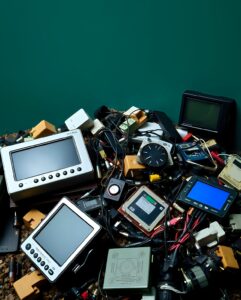Description
E-waste recycling refers to the process of recovering materials from discarded electronic devices and safely disposing of harmful components. Electronics like computers, phones, televisions, and appliances contain valuable resources such as metals, plastics, and glass, as well as hazardous substances that require special handling. Why 1630,HORNSBY,Northern Sydney Recycle E-Waste? Environmental Protection: Prevents hazardous materials like lead, mercury, and cadmium from polluting landfills and water sources. Resource Recovery: Enables the reuse of valuable metals (e.g., gold, silver, copper) and reduces the need for mining new raw materials. Energy Conservation: Recycling uses less energy compared to extracting and processing virgin materials. Job Creation: The recycling industry creates employment opportunities in sorting, processing, and repurposing materials. Data Security: Recycling services often provide data destruction to protect sensitive personal or business information. Common Items for E-Waste Recycling Computers and Laptops: Includes desktops, hard drives, monitors, and peripherals. Smartphones and Tablets: Devices and accessories like chargers and headphones. Televisions: CRT, LED, LCD, and plasma screens. Small Appliances: Microwaves, toasters, blenders, etc. Audio Equipment: Speakers, headphones, and stereos. Networking Devices: Modems, routers, and cables. The 1630,HORNSBY,Northern Sydney E-Waste Recycling Process Collection: E-waste is collected from consumers, either through drop-off centers, curbside pickup, or specialized collection programs. Sorting: Items are sorted based on type (e.g., computers, phones) and the materials they contain (plastic, metal, glass). Data Destruction: For devices with data storage (computers, phones), recycling centers securely destroy or erase the data. Dismantling: Devices are manually dismantled, separating the different components for further processing. Shredding and Separation: Materials are shredded, and advanced techniques (such as magnets and water separation) are used to extract valuable metals, plastics, and glass. Recycling and Reuse: The separated materials are sent to processing plants for refinement and reuse in the production of new electronics or other products. Benefits of E-Waste Recycling Reduces Pollution: Keeps toxic chemicals out of the environment. Minimizes Landfill Use: Decreases the amount of electronic waste ending up in landfills. Promotes Sustainable Manufacturing: Recycled materials are used to create new products, reducing the demand for new resources. Reduces Greenhouse Gas Emissions: Recycling can significantly reduce the energy and emissions required to manufacture new products from raw materials. Challenges of E-Waste Recycling Complexity: Electronic devices are made up of many different materials, making it difficult to dismantle and recycle them efficiently. Hazardous Components: Some parts, like batteries and cathode ray tubes (CRTs), require special handling and disposal methods. Cost: Proper e-waste recycling can be expensive due to the labor-intensive process and need for specialized equipment. How to Recycle E-Waste Drop-Off Centers: Many local governments and recycling facilities offer drop-off locations for e-waste. Retailer Programs: Some stores (e.g., Best Buy, Staples) accept old electronics for recycling. Manufacturer Take-Back Programs: Companies like Apple, Dell, and HP offer programs to take back and recycle their old products. E-Waste Collection Events: Communities may organize special events where residents can bring e-waste for recycling. Online Recycling Services: Some organizations offer mail-in programs where you can ship your old devices for recycling. Regulations and Standards R2 Standard: Ensures that recyclers operate with high standards for environmental protection and worker safety. e-Stewards Certification: A global certification for responsible recycling and refurbishing of electronics. WEEE Directive (EU): The European Union’s Waste Electrical and Electronic Equipment directive regulates the recycling of e-waste across member states. What You Can Do to Reduce E-Waste Repair Instead of Replace: Consider fixing devices before buying new ones. Donate or Sell Old Electronics: Give functioning devices a second life by donating or selling them. Buy Environmentally Friendly Electronics: Choose products made from recycled materials or designed for easier recycling. Dispose of Electronics Properly: Always recycle e-waste at certified facilities to ensure it’s handled safely. By recycling e-waste, we can conserve valuable resources, protect the environment, and create a more sustainable future.

Reviews
There are no reviews yet.